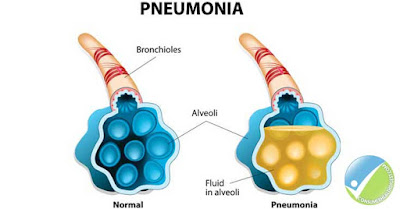Community acquired pneumonia
refers to pneumonia acquired outside of hospitals or extended care facilities.
Nosocomial pneumonia and hospital acquired pneumonia describe infections
acquired in the hospital setting. The symptoms
and signs of acute pneumonia develop over hours to days, whereas the
clinical presentation of chronic pneumonia frequently evolves over weeks to months.
The causative agent of community acquired pneumonia remains unidentified in
thirty% to 50% of cases. Inhalation of infectious particles is one of the most
crucial pathogenetic mechanism in the development of community acquired
pneumonia, with special importance of pneumonia caused by Legionella species and M.
Tuberculosis. Direct inoculation rarely occurs as a consequence of surgery or
bronchoscopy, but might play a part in the development of pneumonia in patients
supported with mechanical ventilation.
Since the clinical syndromes
characterizing pneumonic infections caused by various agents frequently overlap
one another and since interobserver variability regarding physical results of
pneumonia is high, the diagnosis of pneumonia can be challenging. Influenzae
Adapted from Mandell LA, Bartlett JG, Dowell SF, et al: Update of practice
guidelines for the management of community acquired pneumonia in
immunocompetent adults. The composition of the diagnostic workup for pneumonia
has been the subject of some disagreement among experts, but a well chosen
evaluation can support a diagnosis of pneumonia and identify a pathogen. A
study by the Patient Outcome Research Team investigators has validated a risk
scale, now called the pneumonia severity index, for mortality in community
acquired pneumonia.
Since these procedures may carry
considerable morbidity, they're usually reserved for the deteriorating patient
with a pneumonia that defies diagnosis by less invasive techniques. Powerful
molecular techniques are now being applied to the early diagnosis of pneumonia.
Given the large proportion of pneumonia cases for which no microbial cause is
identified, it's likely that molecular tools will ultimately be applied to the
identification and anti-microbial susceptibility testing of virtually all
causative agents of pneumonia. The pneumonia severity index uses history,
examination, chest radiograph, and initial laboratory test results to identify
low risk patients for outpatient treatment. Antibiotic therapy for community
acquired pneumonia should always be selected with patient characteristics,
place of acquisition, and severity of disease in mind. Organisms with intrinsic
or acquired resistance to drugs commonly utilized in pneumonia therapy should
also be considered. A secondary infection, like postinfluenza staphylococcal
pneumonia, might prove resistant to initial therapy. Criteria for hospital
discharge in community acquired pneumonia are based on common sense.
Read here on
Pneumonia Treatment by Health Care on Scribd

No comments:
Post a Comment